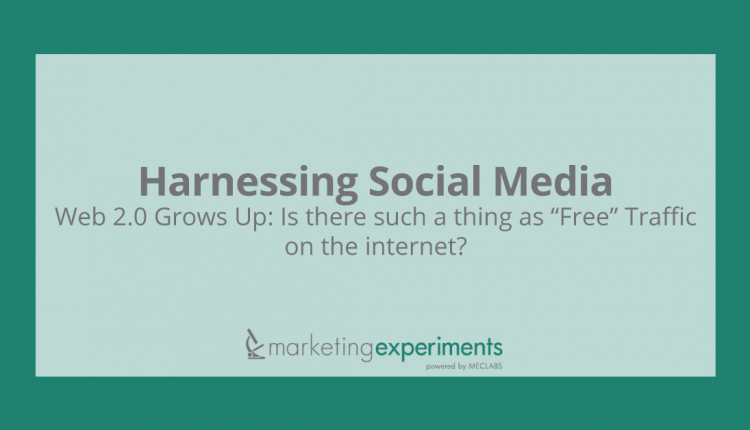EDITOR’S NOTE: You can listen to a recording of the clinic by using the link below.
Web 1.0 was the Web in its infancy, its first developmental stage.
“Web 2.0” was coined by O’Reilly Media in 2004. You can think of it as the Web in its adolescence, full of energy and ambition with real meaning and purpose to its life.
Web 3.0 is the Web grown up. It is what the Web was meant for. “A Web guided by common sense,” as the New York Times put it, where there is real value content integrated with video, text, images, and personal interaction on a level that may lead to a kind of artificial intelligence. Of course, this is certainly not the final stage, maturation, evolution of the Web. But for the moment it is an exciting development that with broadband proffers unlimited possibilities.
Online sharing communities, for instance, have replaced the old concept of personal websites with blogging. Another dramatic development was the wiki, “a website that allows visitors to add, remove, and edit content” (The American Heritage® Dictionary of the English Language, Fourth Edition).
A radical departure from standard search engine use has been the evolution of folksonomies, the use of open-ended labels called “tags” that make “sense to users and often results in an immediate and rewarding gain in the user’s capacity to find related content” (Wikipedia).
Is it possible to use this nascent web, and the emerging social media trends to reach our target market more effectively and inexpensively than paid search? This was the question we sought to answer with this 12 month research study. What we found was that, by understanding and applying a set of new principles and steps, we were able to generate over 1400% better ROI using SMO to drive over 90,000 targeted clicks to our websites. Here is how:
Background:
Graphically the maturation and evolution of the Web can be seen at a glance below.
| Web 1.0 | Web 2.0 | Web 3.0 |
|---|---|---|
| Spam | Blogs | Real content |
| SEO | Tagging | No spam |
| Submission | Online video | No hype |
| Doorway | Subscriptions | Integrated content |
| Pages | PPC | Word travels |
| Ecommerce | Backlinks | Pay only for value |
What is social media?
The term started with Rohit Bhargava of Ogilvy Public Relations in 2006.
Social media is a collective term for online interactive “technologies and practices that people use to share opinions, insights, experiences, and perspectives” (Wikipedia).
Social media includes social media applications like Wikipedia (reference), MySpace (social networking), Gather.com (social networking), YouTube (video sharing), Second Life (virtual reality), Digg (news sharing), Flickr (photo sharing) and Miniclip (game sharing).
Social media provides the kind of interaction among online users that the Web was made for.
Start with Metcalf’s Law.
Metcalfe’s Law states that the value of a telecommunications network is proportional to the square of the number of users of the system (n2). In other words, a network increases exponentially with the number of nodes.

As you can see from the above the value of the network is a function of how many nodes there are. The more users, the more valuable the network and the faster information and opinion, as well as the network’s use, can spread.
Social Media Optimization is essentially quality (How good is my content?), quantity (How much do I have?) and channel (How broadly is what I have distributed?). It is the new word-of-mouth. It is a question of how many people originally see what I have to offer and go on to tell someone else. To put it another way, Can we drive traffic for free?
Social media ties everything together. Social media optimization encompasses
- Web 2.0 activities,
- Natural Search
- Paid Search
- Banners and newsletters
- Partnerships/Affiliates
Is there such a thing as “Free” Traffic on the internet?
A 12 month study in Social Media Optimization (SMO) generates a 1,427% (and counting) better ROI than Paid Search
Case Study:
In an attempt to answer this question, we embarked on a research project designed to determine whether or not there is potential to drive a significant amount of web visitors to your site without paying for those visitors.
We built a total of 4 sites over a period of 12 months. Here is a brief summary of the sites we created:
- HollywoodSquared.com
WordPress BlogA site dedicated to the advancement of struggling artists. Vote to send them to Hollywood, and in turn they get to build a fan base online. - i58Projects.org
Custom PHP WebsiteA site focused around one thing: the care of the some 80 million orphans in India. Does doing good spread? - SweatbandMan.com
Movable Type BlogSweatbands are cool, but how cool? Sweatband Man finds out and by involving people in the content gets more than just lots of laughs. - 2008PresidentialPoll.com
Movable Type BlogWhom do you want to win? Nominate anyone. A simple free poll.
We then began an experiment to determine which would be a better marketing tactic for these sites:
1. Hiring an employee at $10 per hour to blog, create content, and in general work to drive traffic to the sites?
-or-
2. Using Google Adwords to drive targeted traffic?
Over a period of 12 months, we identified all of the active online blogs and discussion boards that might be interested in our site topics.
We posted 255 relevant blog excerpts and attempted to engage in real and meaningful conversation with the community. In all cases, we included a link back to our own site.
| Large Active Communities Online | Particular Social Communities We Used for Specific Topics |
|---|---|
| Myspace | American Idol Blog |
| YouTube | TVGasm |
| Google Video | WWE Blogs |
| Wikipedia | MTV, NBC, ABC, chat rooms |
| Fark | NY Times Blog |
| imBored | Digg |
| Hi5 | Delicious |
| iVillage | |
| Google Groups | |
| Craigslist |
In all, over the 12 month test this approach yielded more than 93,000 visits to our site.
We then conducted a 30-day test of Google Adwords, bidding up to 75¢ per click on a variety of keywords related to the test websites.
Over the course of the month, we were able to drive 2,047 total users, spending $1,250 with Google.
In total, our “word-of-mouth” efforts yielded us 93,207 unique visitors and we incurred a total salary cost of $3,600.
| Total Visitors | Total Cost | Cost Per Visit | |
|---|---|---|---|
| Social Media Optimization | 93,207 | $3,600 | 4¢ |
| Google Adwords | 2,057 | $1,250 | 61¢ |
What you need to understand: Social Media Optimization yielded 1,427% greater return on our investment.
The initial test of social media, proved to be very successful from a traffic generation standpoint.
Pay-per-click advertising was a much easier and quicker form of advertising. Within minutes, and with the click of a button, we found we could drive traffic, while our SMO campaign spanned a period of 12 months.
Furthermore, our SMO efforts required constant trial and error and at times disrupted the community in which we were trying to become a part of, possibly negatively impacting our brands. In some cases we were accused of spam and worked to avoid posting unrelated comments or discussion.
A large part of our SMO activities also included the creation of 44 amateur videos, which were posted on YouTube, and viewed 1.3 million times.
Based on our initial research, it appears that while actually generating free viral traffic online requires creativity and patience, creating an SMO strategy can be a very worthwhile investment.
Each campaign will require a specific strategy and set of tactics and much more is still to be learned about SMO.
In general, here are 6 basic steps for developing an SMO Campaign:
- Pick a theme related to your core content that is actively being discussed online. There is a real standard deviation curve (correlation) between what is being discussed and what is being searched for. If, for instance, if you had Don Imus content on your site the day he was fired, you would be in a good position to turn up in top searches. You do not have to have a crystal ball, but you can look for something topical in your content or that you can blog about. That’s the key to opening discussion, dialogue, hits, backlinks, and all the things that go into making someone want to respond by passing on what you’ve got to offer. It can’t be something nobody’s been talking about.
- “Become” your own customer. Instead of spending advertising dollars and putting up billboards or trying to create buzz with some kind of demonstration in, say, Times Square, you’ve got to go not as a corporation but as a person to someone’s site and continue the dialogue by stirring the pot with something interesting. You become their customer and thereby in a twist of the screw become your own customer. You can even hire people to do this.
- Develop content specifically for “broadcast.” If your demographic is a 50—year-old woman, hire such a woman to develop content-specific material from what’s already out there. Have her put bits and pieces together in little videos, images, and mini articles—things that are going to get pushed all over the place.
- Identify a platform that is SMO friendly. We use Blogger, WordPress, and Movable Type as the website platform and Google and Linux for tracking. Choose what best seems to suit you. There are a number of Web 2.0 tools, little tagging tools and keyword clusters etc. that you can employ.
- Use ad dollars to prime the community. Do your homework. See what’s already out there on the Web and start talking about something you find already being talked about, adding some content. You might want to spend some money to get people to blog for you.
- Get engaged in the community. This is the stage where you make a long term commitment to be in the community. You could take 10% of your advertising budget and start adding some valuable content to the community that will build a long-term “portfolio” network. Invest in the community.
You may also listen to the original Web clinic “Harnessing Social Media“.
Related MarketingExperiments Reports:
As part of our research, we have prepared a review of the best Internet resources on this topic.
Rating System
These sites were rated for usefulness and clarity, but alas, the rating is purely subjective.
* = Decent | ** = Good | *** = Excellent | **** = Indispensable
- Social Media Optimization: The Backlash ****
- What Is Social Media? An e-book from Spannerworks ***
- Social Media: Or How I learned to Stop Worrying and love Communication, Trevor Cook and Lee Hopkins. ***
- Viral Marketing ***
- Viral Marketing ***
- New Rules for Social Media Optimization ***
- Social Media Optimization: 13 Rules of SMO ***
- How to Build Word-of-Mouse Marketing ***
- The Six Simple Principles of Viral Marketing ***
- MarketingSherpa’s Viral Marketing Hall of Fame 2006: Top 12 Campaigns You Should Swipe Ideas From ***
- Is Social Media the Next Online Wave? **
- Social Media Links **
- Word of Mouse **
- Technology: More Companies Pay Heed to Their ‘Word of Mouse’ Reputation **
- Tips for Optimizing Viral Marketing Campaigns **
- The Basics of Viral Marketing **
Credits:
Editor(s) — Bob Kemper
Frank Green
Writer(s) — Jalali Hartman
Frank Green
Contributor(s) — Flint McGlaughlin
Nick Usborne
HTML Designer — Cliff Rainer



